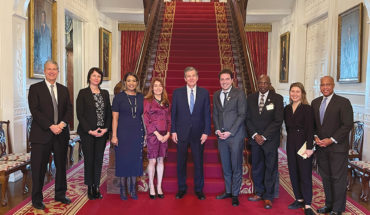by Charles Upchurch
photograph by Juli Leonard
The Paris Ritz is closing. The Hemingway Bar has been shuttered since April. I read these dreadful words recently and was plunged into a near panic. I had never been. The old haunt of Hem and Scott Fitzgerald in the ,20s. Where in August 1944, Papa rolled up in a commandeered Jeep with a band of strays to liberate his beloved bar and its champagne cellar from the retreating Nazis. Closing? My dreams, I feared, were on a broad reach, beating back ceaselessly into the past.
Thank God it wasn’t true.
The Ritz is closing down, yes, but only temporarily, as the grand old dame gets a facelift, reopening in 2014. One dream, at least, is safe for now. And that’s worth celebrating in the bubbliest of fashions. Not simply with champagne, but something even more luxurious – a champagne cocktail.
What is it about champagne that charms us so? It is our companion at the biggest moments of life. At the christening of ships and dinners of state. A symbol of arrival, of passage, of years only seconds old, and of long-surviving love. And does it get any more swashbuckling than sabrage? The art of opening a bottle of champagne with a sword is said to have its origins during the return of Napoleon’s armies from far-ranging conquests. When the cavalrymen were welcomed home with bottles of French champagne, they expedited the celebration by cleanly removing the top, cork and all, with a deft stroke of a battle saber.
That’s just cool.
But while most of us won’t be sabering a jeroboam of Röederer Cristal, Dom Perignon or Veuve Clicquot any time soon, the champagne cocktail is an indulgence that will satisfy your taste for something tres fabuleux and deliciously decadent.
There are, of course, two standard recipes that qualify as a classic champagne cocktail: both starting with a chilled flute, into which is added a sugar cube dashed with Angostura bitters, followed by very cold champagne – carefully poured to avoid an excited eruption of bubbles – and garnished with a cherry, orange slice or lemon twist.
For many, that’s it. Simple, sultry and exquisite on the palate. You’ll find it exactly that way at Margeaux’s on Creedmoor Road, poured from splits of Kenwood California Cuvée. Also at Heron’s at Cary’s Umstead Hotel, built upon Nicolas Feuillatte Brut. Both executed to perfection, both true to a lineage largely unchanged for more than 150 years. But the champagne cocktail has a twin – the naughty one. The one finished with a float of brandy. That, friends, is a cocktail.
The brandy- or cognac-laced version gets the nod from the International Bartenders Association. Probably because the recipe is included within the pages of world’s first cocktail guide, How to Mix Drinks – The Bon Vivant’s Companion, published in 1862 by America’s first superstar bartender, Jerry Thomas.
The Tavern at Second Empire delivers the goods: sugar, bitters, Perrier Jouet and a kiss of St. Remy. The takeaway is body – svelte, seductive and doubly French – with a kick worthy of the Latin Quarter.
Do you need a pedigreed champagne to make this age-old magic? Not at all. The sugar and bitters – certainly, the brandy – along with your incandescent mood, will mask the imperfections of a garden-variety label. In fact, any flavorful sparkling wine, cava, prosecco or spumanti will do nicely. Nor should one consider it risking sacrilege to muck up the good stuff. After all, among those who consider it made for excess, there is no such thing as wasting champagne.
And let us lay to rest whether gentlemen can order champagne cocktails and still retain their man cards. To wit: Casablanca. Victor Laszlo suavely orders champagne cocktails at the bar before rallying the band and the expats at Rick’s into an emotional rendition of La Marseillaise, drowning out the singing of German officers. And just to rub it in, someone calls for a round of French 75s. A cocktail of champagne, gin, lemon juice and sugar, the French 75 was created at the New York Bar in Paris in 1915 and named for a piece of field artillery the Germans may have remembered none too fondly. You’ll find a bang-on version on the cocktail menu at Bloomsbury Bistro, with cognac replacing Bombay for the winter season.
Champagne has been blended with spirits ever since, well, ever since there have been champagne and spirits. Chatham Artillery Punch (anyone notice a trend here?), a Southern staple by way of Savannah that dates back at least to 1850, is basically a giant champagne cocktail in a washtub. The traditional recipe reads like a ship’s manifest for an ocean crossing, but modern iterations call for sugar, lemon juice, bourbon, brandy, rum and a boatload of champagne, stirred up with copious amounts of ice. As with any live ordnance, caution is recommended.
Around Raleigh, creative takes on champagne-based punches, cocktails and highballs are making the rounds. At Sitti, try the Mata Hari, featuring Simonet Brut and bitters, gently sweetened with a candied hibiscus flower. You just know there’s a story there somewhere.
In 1935, Hemingway was asked to contribute a recipe to a cocktail book being published that year. His entry, titled Death in the Afternoon, read thusly: “Pour one jigger absinthe into a champagne glass. Add iced champagne until it attains the proper opalescent milkiness. Drink three to five of these slowly.” Due to a dearth of absinthe locally, I have yet to experience the reverie induced by a properly-made Death in the Afternoon. It may have to wait. I’m sure they will have absinthe at the Ritz.




